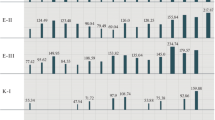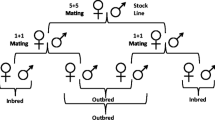Abstract
Strong sexual isolation established between D. melanogaster long-term cage populations (originated from common parents and being under selection pressure since 1972) is maintained (with a tendency to increase) for twelve years after the origin of the populations. The sexual isolation is also maintained when the populations are kept in common conditions for about two years, while it dramatically decreases when the populations live on a food medium supplemented with strong chemical selective factors, such as various metals or ethanol. Seasonal or geographical studies of sexual isolation between natural and our cage populations did not reveal significant deviation from random matings. The genetic nature of sexual isolation is discussed.
Similar content being viewed by others
References
Alahiotis, S., 1976. Genetic variation and the ecological parameter ‘food medium’ in cage populations of Drosophila melanogaster. Can. J. Genet. Cytol. 18: 379–383.
Alahiotis, S., 1983. Heat shock proteins. A new view on the temperature compensation. Invit. minireview for Comp. Biochem. and Physiol. 75B: 379–387.
Alahiotis, S & Pelecanos, M., 1978. Induction of gene pool differentiation in D.melanogaster. Can. J. Genet. Cytol. 20: 265–273.
Alahiotis, S. & Pelecanos, M., 1980. The effect of the environmental parameters temperature and humidity upon the variability of the gene pool in D.melanogaster. Genetika 12: 209–217.
Alahiotis, S. & Stephanou, G., 1982. Temperature adaptation of Drosophila populations. The heat shock proteins system. Comp. Biochem. Physiol. 79: 529–533.
Alahiotis, S., Pelecanos, M. & Zacharopoulou, A., 1976. A contribution to the study of linkage disequilibrium in D.melanogaster. Can. J. Genet. Cytol. 18: 739–745.
Alahiotis, S., Zacharopoulou, A. & Pelecanos, M., 1979. The effect of two ecological factors upon the inversion frequencies in D.melanogaster cage populations. Dros. Inform. Serv. 52.
Anderson, S. M., McDonald, J. E. & Santos, M., 1981. Selection at the Adh locus in Drosophila melanogaster: Adult survivor-shipmortality in response to ethanol. Experientia 37: 463–464.
Christie, N. T., Paton, C. L., Smith, L. H., Witschi, H. R. & Lee, E. H., 1982. Chemical softness and acute metal toxicity in mice and Drosophila. Toxicol. appl. Pharmacol. 63: 461–475.
Christie, N. T., Williams, M. N. & Jacobson, K. B., 1985. Genetic and physiological parameters associated with cadmium toxicity in Drosophila melanogaster. Biochem. Genet. 23: 571–583.
David, J. R., Van, Herrewege, J., Monelus, M. & Prevosti, A., 1979. High ethanol tolerance in two distantly related Drosophila species: a probable case of recent convergent adaptation. Comp. Biochem. Physiol. 63C: 53–56.
Dodd, D. M. B. & Powell, J. R., 1985. Founder-flush speciation: an update of experimental results with Drosophila. Evolution 39: 1388–1392.
Elens, A. A. & Wattiaux, J. M., 1964. Direct observation of sexual isolation. Dros. Inf. Serv. 39: 118–119.
Harsanyi, Z., Granek, I. A. & MacKenzie, D. M., 1977. Genetic damage induced by ethyl alcohol in Aspergillus nidulans. Mutation Res. 48: 51–74.
Henderson, N. R. & Lambert, D. M., 1982. No significant deviation from random mating of worldwide populations of Drosophila melanogaster. Nature 300: 437–440.
Hougouto, N., Lietaert, M. C., Libion-Mannaert, M., Flytmanns, E. & Elens, A., 1982. Oviposition-site preference and ADH activity in Drosophila melanogaster. Genetica 58: 121–128.
Jones, M. M. & Vaughn, W. K., 1978. HSAB theory and acute metal ion toxicity and detoxification processes. J. inorg. Nucl. Chem. 40: 2081–2092.
Kilias, G. & Alahiotis, S. N., 1982. Genetic studies on sexual isolation and hybrid sterility in long-term cage populations of Drosophila melanogaster. Evolution 36(1): 121–131.
Kilias, G., Alahiotis, S. N. & Onoufriou, A., 1979. The alcohol dehydrogenase locus affects meiotic crossing-over in Drosophila melanogaster. Genetica 50: 173–177.
Kilias, G., Alahiotis, S. N. & Pelecanos, M., 1980. A multifactorial genetic investigation of speciation theory using Drosophila melanogaster. Evolution 34(4): 730–737.
Libion-Mannaert, M., Delcour, J., Deltombe-Lietaert, M. C., Lenelle-Montfort, N. & Elens, A., 1976. Ethanol as a ‘food’ for Drosophila melanogaster: influence of the ebony gene. Experientia 32: 22–23.
Malogolowkin-Cohen, Ch., Simons, A. S. & Lovene, H., 1965. A study of sexual isolation between certain strains of Drosophila paulistorum. Evolution 19: 95–103.
Maroni, G., Lastowski-Perry, D., Otto, E. & Watson, D., 1986. Effects of heavy metals on Drosophila larvae and a metallothlonein cDNA. Environm. Health Perspect. 65: 107–116.
Mayr, E, 1963. Animal species and evolution. Belknap Press, Harvard.
Moxon, L., Homes, R. & Parsons, P., 1982. Comparative studies of aldehyde oxidase, alcohol dehydrogenase and aldehyde resource utilization among australian Drosophila species. Comp. Biochem. Physiol. 71B: 387–395.
Nei, M., 1975. Molecular population genetics and evolution. North-Holland Publ. Co., Amsterdam-Oxford.
Nevo, E., 1983. Adaptive significance of protein variation. In ‘Protein Polymorphism: Adaptive and Taxonomic significance’ edited by G. S. Oxford and D. Rollinso, Academic Press.
Nevo, E., Ben-Shlomo, R. & Lavie, B., 1984. Mercury selection of allozymes in marine organisms: prediction and verification in nature. Proc. natn. Acad. Sci. USA 81: 1258–1259.
Nevo, E., Lavie, B. & Ben-Shlomo, R., 1983. Selection of allelic isozyme polymorphisms in marine organisms: pattern, theory and application. In: Isozymes: Current topics in Biological and medical research. Vol. 10: Genetics and Evolution 69–92 (Alan Liss Inc. N.Y.).
Petit, C., Kitagawa, O. & Takamura, T., 1976. Mating system between japanese and french geographic strains of Drosophila melanogaster. Japan. J. Genet. 51: 99–108.
Tauber, C., Tauber, M. & Nichols, J., 1977. Two genes control seasonal isolation in sibling species. Science 197: 592–593.
Varnavas, S., Ferentinos, G. & Collins, M., 1986. Dispersion of Bauxitic red mud in the gulf of Corinth, Creece. Marine Geology. (In press).
Williams M. W., Hoeschele J. D., Turner J. F., Jacobson K. B.,
Author information
Authors and Affiliations
Rights and permissions
About this article
Cite this article
Kilias, G., Alahiotis, S.N. The effect of metals and alcohol on sexual isolation in Drosophila melanogaster . Genetica 75, 31–37 (1987). https://doi.org/10.1007/BF00056030
Received:
Accepted:
Issue Date:
DOI: https://doi.org/10.1007/BF00056030




